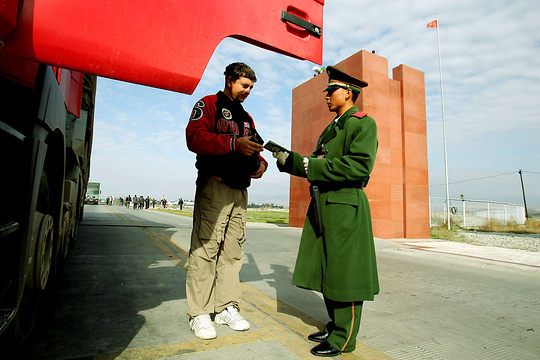
China’s Latest Piece of the New Silk Road
Publication: Eurasia Daily Monitor Volume: 10 Issue: 4
By:

While the concept of a “New Silk Road” of trade, transport and telecommunications connections across Eurasia was formally endorsed by the US State Department, it is Beijing and Chinese companies that have taken the lead in realizing the immense infrastructure projects that will tie the mega-continent together. The latest is the completion of a second railway link between China and Kazakhstan at the burgeoning Khorgos crossing point and Special Economic Zone. This nearly 600-kilometer section is part of a larger project that connects China’s eastern port of Lianyungang with Kazakhstan’s rail system and points west toward Russia and the Caspian region. Chinese officials refer to it as part of the New Eurasian Land Bridge from China’s ports to Western European ports such as Rotterdam (Global Times, December 22, 2012).
Plans call for the railway to handle 20 million tons of freight by 2020, increasing to 30 million by 2030. The 292-km Chinese portion of the project was built for less than $1 billion—relatively inexpensive by global standards. Khorgos is already the key border crossing for the Central Asia–China natural gas pipeline from Turkmenistan and a new highway network under construction. According to Kazakhstan’s Minister for Transport and Communications Askar Zhumagaliyev, 800 km of this Western Europe–Western China highway will be completed in 2013, with much of the route running alongside the just-completed railway (Tengrinews, December 20, 2012).
China’s Transportation Association claims that goods transported from China’s east coast to Western Europe along the railway should be delivered in one fifth of the time it takes for maritime transport (China Daily, December 6, 2012). Overland transport is particularly cost-effective for high-value-added goods such as electronics, machinery and appliances. In fact, such goods make up 30 percent of China’s exports to Shanghai Cooperation Organization (SCO) countries, including Russia. According to the China Transportation Association, “Although the delivery cost of railway transport is higher than sea transportation, the greater time-efficiency of land transport can result in quick cash return” (China Daily, December 6, 2012). But, such calculations assume time-efficiency, and numerous studies by the Asian Development Bank, the World Bank and Central Asia–Caucasus Institute at Johns Hopkins SAIS have shown that the greatest obstacle to the implementation of the New Silk Road vision is the issue of time efficiency.
Complicated customs procedures and competition for bribes at numerous Central Asian borders crossings often hamper road and rail traffic. In 2012, Kazakhstan’s border with China was the focus of numerous incidents involving mutinous and deserting border guards, disputes amongst officials of overlapping agencies and allegations of smuggling and large-scale bribery (see EDM July 10, 2012). A new head of the border service was appointed this summer to reform the organization, but he died in an accidental plane crash, along with twenty high-ranking colleagues on December 25, 2012 (Tengrinews, December 26, 2012). A permanent successor has yet to be named. When visiting the Khorgos crossing from both sides of the border last year, the author witnessed significant delays due to lengthy customs procedures. Kazakhstan’s state rail carrier, Temir Zholy, has since taken over operation of Khorgos’ Kazakhstani side, with procedures said to be increasingly professionalized (see EDM, July 10, 2012).
Short-term delays tend not to worry Chinese officials, however, who view the second Khorgos railway as part of a larger effort to engage with SCO member states on trade and development. This effort is in turn part of Beijing’s “Develop the West” strategy in restive Xinjiang province: a priority project to achieve stability and political control through investment and economic growth. The second annual China-Eurasia Expo, held in Urumqi in September 2012 and attended by Premier Wen Jiabao, served as a showcase for the link between some of China’s top domestic concerns in Xinjiang and its infrastructure projects in Central Asia (Xinhua, September 3, 2012).
At an SCO meeting on December 6, 2012, Wen pressured China’s Central Asian neighbors to take advantage of a $10 billion soft loan offer from China Eximbank and Development Bank of China for infrastructure and industrial development. Both institutions are eager to spend the money on another major New Silk Road rail project, from Kashgar in Xinjiang to Andijan in Uzbekistan’s Ferghana Valley. Chinese and Kyrgyzstani officials are already in intense negotiations about the routing and terms of the planned project (Business New Europe, December 6, 2012)
In principle, US and Chinese “New Silk Road” visions have a lot in common. However, Washington’s focus is on northeast-southwest links that integrate Afghanistan with its Central and South Asian neighbors and thus serve as corridors of interconnectedness, development and stability. In contrast, so far at least, Beijing has pursued an “all roads lead to Urumqi” strategy on a largely east-west basis. Moreover, while Washington policymakers can nudge private sector investors in the right direction, China’s political will, available funding and geographic contiguity mean that its vision is steadily coming to fruition, project by project.




